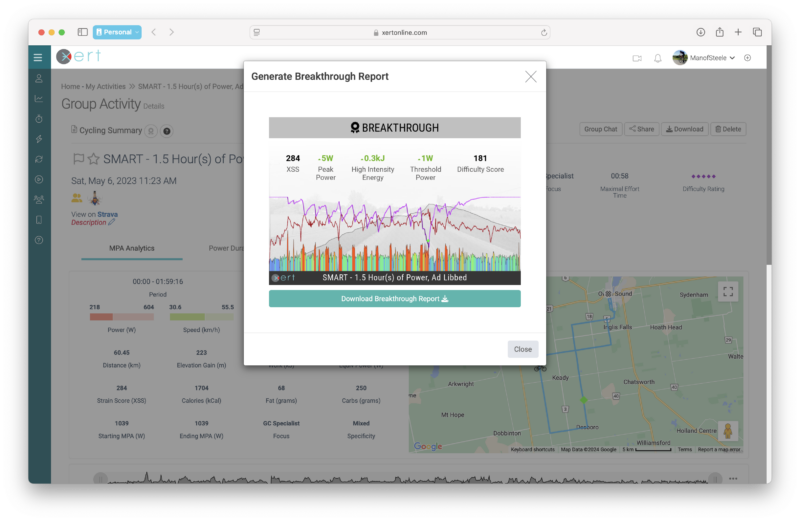Understanding Your Fitness Signature
![]()
Your Fitness Signature is at the heart of everything Xert does. It represents your unique ability to generate power across various intensities and is constantly evolving based on your training. Xert uses your fitness signature in multiple ways to track and optimize your performance:
- Progression Tracking: Xert tracks how your fitness signature changes over time, helping you see how your fitness evolves.
- Athlete Type: Your fitness signature helps determine your athlete type (e.g., 5-minute power), providing insights into how you’re progressing toward specific fitness goals.
- MPA Calculation: Xert calculates Maximal Power Available (MPA) second-by-second for each activity, which is key to understanding your power limits during training or races.
- Key Metrics: Using MPA and your fitness signature, Xert calculates metrics like Focus, Stress, Strain, and Specificity Rating, giving you valuable insights into your performance.
- Workout Optimization: Xert’s Workout Designer uses your fitness signature to generate workouts that align with your current fitness level and goals.
- Real-Time Feedback: Your fitness signature is used in Garmin data fields & Xert EBC apps for Android & iOS for real-time performance tracking.
- Segment Hunter: Xert’s Segment Hunter uses your fitness signature to calculate target power during segments, helping you perform at your best.
Your fitness signature isn’t static—it changes with your training, improving as you push your limits and declining if you stop training. Xert provides several tools to help you maintain and optimize your fitness signature. In essence, Xert helps you manage your fitness, track your progress, and perform at your best.
Understanding MPA – What is it and Why Is It Important?

At first glance, an MPA chart may look like just a simple graph showing your power data (multi-coloured line) alongside your Maximal Power Available (MPA) (in magenta). The MPA line appears to meander up and down, sometimes coming down far enough, or power rising high enough for them to touch. What’s the big deal?
Your fitness signature, combined with your power data, allows Xert to calculate MPA. In simplest terms, MPA is your limit of power. While the phrase “push your limits” is common in cycling and other sports, Xert is the first software to show you exactly what your limit is, second by second. In other words, when Xert displays your MPA, it provides real-time feedback on how close you are to reaching your limit. As you push harder, your power may approach or even exceed your MPA, especially during maximal efforts. If you’ve ever been dropped in a group ride or race, you’ve experienced firsthand how your MPA can limit your performance. If you’re able to continue pushing power that surpasses your MPA, it signals a Fitness Breakthrough, indicating that you’ve pushed beyond your previous limits & that your fitness has improved!
Think of MPA as the defining factor for your fitness. For instance, noodling at low intensity (like 50 Watts) doesn’t tell us much about your fitness. However, as the intensity increases, your ability to sustain higher power outputs becomes a true measure of your fitness. Athletes who fatigue less at higher intensities and sustain power longer are considered fitter. The moment one athlete can no longer keep up with another – reaching their MPA and hitting their limit – is where fitness can be compared.
To understand MPA more clearly, check out this story of a ride with Peter Sagan.
Understanding Fitness Signature Extraction
What is “Signature Extraction”?
Every time you upload or sync an activity, Xert automatically performs a signature extraction. This analysis determines the best fitness signature parameters that represent your MPA during that activity. The process involves comparing MPA data with your power output to identify the fitness signature that best matches how you fatigued and recovered during the session.

How It Works:
- Automatic Extraction: When an activity is synced, Xert uses your current fitness signature to calculate second-by-second MPA for the activity.
- Breakthrough Detection: If the activity includes a fitness breakthrough, where your power exceeded your MPA, Xert will identify this and update your fitness signature accordingly. The Breakthrough Report will indicate how your fitness signature has changed as a result of the Breakthrough. The type of the breakthrough depends on which aspects of your fitness improved:
- Gold: All three fitness signature parameters increased
- Silver: Two of your fitness signature parameters increased
- Bronze: One of your fitness signature parameters increased
- Empty: a Near-Breakthrough is where you were very close to your MPA, but you didn’t quite hit it. Your fitness signature might be reduced a tad. These are often referred to as “fakethroughs” by Xerters
- Results: After the extraction, Xert re-calculates key metrics, such as:
- Xert Strain Score: divided into Low, High, & Peak systems
- Focus & Specificity Rating: help us understand which system(s) were trained as a result of your ride
These metrics help you understand the intensity and focus of your workout, ensuring that you’re on track to meet your goals.
The “Trickle-Down” Process
What Happens When You Add or Modify Activities?
Xert uses a trickle-down process to update your progression whenever a new activity is added or an older activity’s fitness signature is updated. This process recalculates your fitness signature and progression, ensuring that your fitness history remains accurate and reflective of your most recent workouts. You’ll see a green progress bar saying ‘Fitness signatures are being updated…‘ & ‘Fitness signature updates are complete‘ at the top of your account while this process runs:

After completing the trickle-down process, your current fitness signature may be affected.
For example, if you insert a fitness test activity into your training history, Xert will extract a new fitness signature from that activity and update all subsequent activities with the updated fitness signature, of course all while searching for new Breakthroughs along the way. If you flag an activity, Xert will ignore the signature from that ride to prevent inaccurate data from impacting your progression.
This process allows you to focus on breakthroughs and tests, while Xert manages the rest of your training history.
Your First Batch of Activities
When you first upload your activities to Xert, the platform will look at your earliest activity to establish an initial fitness signature. From there, Xert will update your fitness signature over time as new activities are added. The better data you provide – meaning more maximal/breakthrough efforts, the more accurately Xert can track your fitness and optimize your training.
If you notice any discrepancies or if you’re missing maximal effort data, you can use the Fitness Signature Calculator to correct or refine your signature. Performing MPA Analysis on an activity can also help guide Xert’s signature progression.
XPMC Progression Chart
At the bottom of your My Fitness page, you’ll find your Xert Performance Management Chart (XPMC), which provides an overview of your fitness and training over the selected period. Key metrics displayed on the chart include:

- Breakthroughs – Represented as coloured circles
- Training Load – Solid back line
- XSS – Low, High, & Peak XSS are displayed as the Blue, Yellow, & Red Matchsticks
- Threshold Power – Gold hatched line
- Form – Multi-coloured line
You can zoom in on the chart to view specific date ranges and click on the circles to view activity details. This chart helps you track your progress and understand how your training is impacting your fitness over time.
Conclusion
Understanding your Maximum Power Available (MPA) and how it relates to your fitness signature is crucial for optimizing your training and performance. Xert’s real-time feedback allows you to see exactly where your power limits lie and helps you track your progress with unprecedented precision. By continuously pushing your limits and achieving Fitness Breakthroughs, you can unlock new levels of performance and refine your training strategy. With Xert, you don’t just train harder; you train smarter, with the data and insights needed to truly maximize your potential. Whether you’re training for a race or simply looking to improve, Xert provides the tools to help you break through barriers and reach new heights.
Updated 19 Dec 2024





